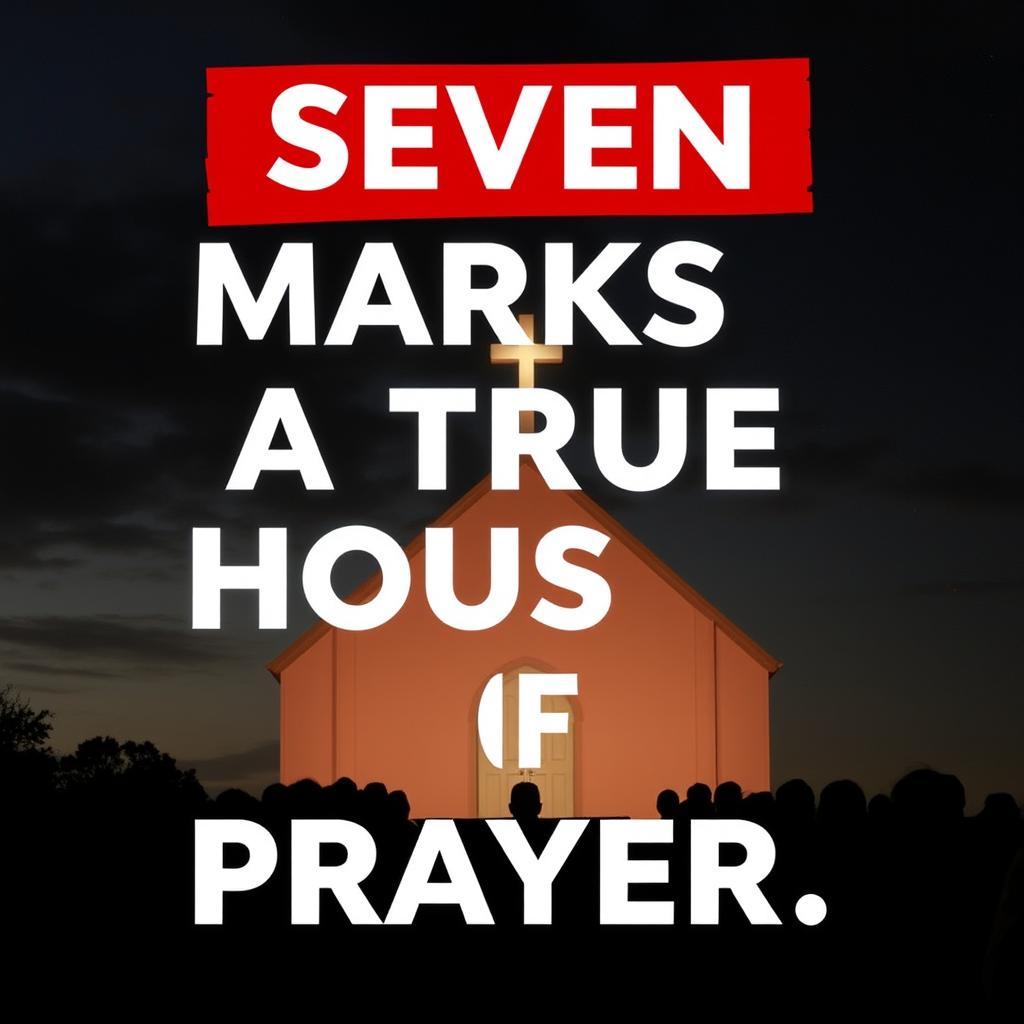Churches are meant to be places where people come together to worship, fellowship, and grow in their faith. But more than just a gathering place, the church is also meant to be a house of prayer—a space where believers connect with God, intercede for others, and seek His will. When we look at the church, the body of Christ, we should ask ourselves: Is this church truly a house of prayer?
Jesus Himself emphasized the importance of prayer in the life of the church. In Matthew 21:13, He declared, “My house will be called a house of prayer, but you are making it a den of robbers.” Jesus was clearing out the temple because it had become a place of commerce and not a place of worship. This moment serves as a reminder of how essential prayer is in the life of the church. But how do we know if a church is truly fulfilling this calling?
Here are seven marks of a true house of prayer—characteristics that show whether a church is living out its purpose as a place of communion with God.
1. A Passionate Commitment to Prayer
A true house of prayer is marked by a passionate commitment to prayer. It’s not just something that happens on occasion; it’s a regular, consistent part of the church’s life. Whether it’s individual prayer, corporate prayer, or prayer gatherings, there’s a palpable desire to connect with God through prayer.
In Acts 2:42, the early church “devoted themselves to the apostles’ teaching and to fellowship, to the breaking of bread and to prayer.” This kind of devotion to prayer was a foundational part of their community life. A church that is a house of prayer is one where people are dedicated to coming together to pray—both for the needs of the congregation and the world.
Ask yourself: Does your church have consistent prayer services? Is prayer a priority in every ministry?
2. A Spirit of Intercession for Others
A house of prayer is marked by intercessory prayer—the act of praying on behalf of others. The church should be a place where members lift up one another’s needs, as well as the needs of the community and the world. It’s about standing in the gap, bringing the burdens of others before God, and asking for His intervention.
The apostle Paul emphasized the importance of intercession in 1 Timothy 2:1, saying, “I urge, then, first of all, that petitions, prayers, intercession, and thanksgiving be made for all people.” A church that is a true house of prayer will not only pray for the spiritual needs of its members but will also intercede for the lost, the hurting, and the broken around the world.
Ask yourself: Is intercessory prayer a regular part of my church’s ministry? Do we pray for others with passion and persistence?
3. A Focus on the Presence of God

A true house of prayer is focused on seeking God’s presence. It’s a place where people gather with a heart to encounter God—not just to go through the motions of religious activity. The church is a sanctuary where people should feel God’s presence, both individually and corporately.
In Psalm 27:4, David says, “One thing I ask from the Lord, this only do I seek: that I may dwell in the house of the Lord all the days of my life, to gaze on the beauty of the Lord and to seek him in his temple.” A true house of prayer is a place where people long to be in God’s presence, where His Spirit moves, and where hearts are softened and transformed by His love.
Ask yourself: When we gather for prayer and worship, are we truly seeking God’s presence? Is there a deep yearning to encounter Him?
4. A Heart of Worship
Worship and prayer go hand-in-hand in a true house of prayer. Worship is not just about singing songs or performing rituals; it is about offering our hearts to God in reverence, awe, and love. In the Bible, prayer and worship are often intertwined, with people lifting up their voices in adoration and seeking God’s will.
In John 4:24, Jesus tells the Samaritan woman, “God is spirit, and his worshipers must worship in the Spirit and in truth.” Worship is an expression of our love and devotion to God, and it naturally leads to prayer, as we communicate with Him from a place of reverence and surrender.
Ask yourself: Does our worship lead us into prayer and a deeper connection with God? Do we approach worship with sincerity, inviting His presence?
5. A Focus on God’s Word in Prayer
A true house of prayer is committed to praying in alignment with God’s Word. Prayer is most powerful when it is rooted in the promises and truths of Scripture. God’s Word is living and active, and when we pray according to His will, we can be confident that He hears us.
In 1 John 5:14-15, it says, “This is the confidence we have in approaching God: that if we ask anything according to his will, he hears us. And if we know that he hears us—whatever we ask—we know that we have what we asked of him.” A house of prayer teaches its people to pray in accordance with God’s Word, understanding that His will is always good and perfect.
Ask yourself: Does our church teach and encourage prayer that is grounded in Scripture? Are we praying in alignment with God’s promises?
6. A Lifestyle of Prayer Beyond the Church Walls
A true house of prayer is not just a place where people pray during services, but it’s a community of believers who live a lifestyle of prayer. Prayer is not confined to Sunday mornings or scheduled prayer meetings—it is a daily practice that should shape how we live. When we are truly living as a house of prayer, prayer is integrated into every aspect of life.
Paul encourages believers in 1 Thessalonians 5:17 to “pray without ceasing.” A church that is a house of prayer will equip its members to cultivate a prayerful lifestyle. It becomes part of their rhythm—praying in the morning, throughout the day, and at night, seeking God’s guidance in every decision and acknowledging His presence in every moment.
Ask yourself: Is prayer a part of everyday life in our church? Are we living in continual communion with God, both individually and as a community?
7. A Transforming Impact on the Community
A house of prayer is not just about the internal life of the church—it has a transforming impact on the surrounding community. When a church truly becomes a house of prayer, the power of God is released, and it spills out into the world around it. The church becomes a light in the darkness, a place where people come to experience healing, restoration, and salvation.
In Acts 4:31, we read that “After they prayed, the place where they were meeting was shaken. And they were all filled with the Holy Spirit and spoke the word of God boldly.” Prayer has the power to move mountains and change lives, both within the church and outside of it.
Ask yourself: Is our church having a positive, transformative impact on the local community? Are we praying for the lost, the broken, and the needy in our area?
Conclusion: Is Your Church a True House of Prayer?

As you reflect on these seven marks of a true house of prayer, consider your own church. Is it a place where prayer is prioritized, where God’s presence is sought, and where lives are being transformed through a commitment to intercession, worship, and the Word? Is it a church where prayer goes beyond the walls of the sanctuary and becomes a lifestyle for every believer?
If your church embodies these marks, then you are truly part of a place where prayer is at the center of everything. If not, perhaps it’s time to consider how you and your church community can grow in this area. A church that is a true house of prayer is a powerful, life-changing place where God’s Spirit moves and His kingdom is advanced.
Let’s continue to build churches that are not only places of worship but also houses of prayer, where God’s power and presence are evident in every gathering.

